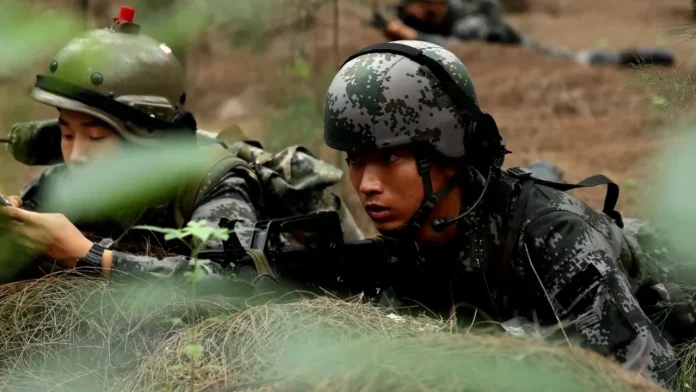As China increases its maritime activities around Taiwan, it is essential to consider the military operations that President Xi Jinping may be planning. This article, based on the Naval War College’s China Maritime Studies Institute’s recent publication Chinese Amphibious Warfare: Prospects for a Cross-Strait Invasion, summarises key findings on the history, doctrine, and development of China’s joint amphibious forces.
Rising tensions in the Taiwan strait
In a development that underscores the growing complexity of cross-Strait tensions, China has escalated military exercises near Taiwan, deploying a combination of naval, air, and civilian maritime assets. According to Taiwan’s Ministry of Defence, China recently carried out its most extensive maritime operations since 1996, involving approximately 60 warships, 30 Coast Guard vessels, and thousands of personnel in waters surrounding Taiwan and Japan’s southwestern islands. The exercises also included significant aerial manoeuvres, with 47 Chinese aircraft operating near Taiwan in a single day, 16 of which crossed the median line of the Taiwan Strait into Taiwan’s air defence identification zone.
China’s military build-up and Taiwan’s geopolitical importance
China has embarked on an unprecedented military expansion, deploying advanced weaponry and conducting rigorous training across multiple domains. Central to Xi Jinping’s geopolitical ambitions is Taiwan, a self-governed island that Beijing regards as part of its territory. Xi’s determination to solidify his legacy and his goal of achieving full military modernisation by 2027 have intensified concerns over a potential invasion of Taiwan. Understanding the strategies and capabilities China may employ in such a campaign is crucial to effectively deterring any aggressive moves.
The Naval War College’s China Maritime Studies Institute has addressed these pressing issues in Chinese Amphibious Warfare: Prospects for a Cross-Strait Invasion. The book provides a comprehensive analysis of China’s historical and doctrinal foundations for amphibious operations and its current capabilities, drawing from expert contributions and in-depth research.
A historical overview of China’s amphibious warfare
The historical context of China’s amphibious ambitions stretches back centuries. Admiral Shi Lang’s 1683 conquest of Taiwan, while distant from modern military considerations, remains a symbolic reference in Beijing’s political narrative. In more recent history, China’s leadership first aimed to capture Taiwan in 1950, with Mao Zedong ordering the People’s Liberation Army (PLA) to prepare for an invasion. However, the outbreak of the Korean War that summer led to U.S. military intervention, postponing Beijing’s plans indefinitely.
The PLA has since refined its approach to amphibious operations, with lessons learned from both successes and failures. The failed assault on Kinmen in 1949 prompted significant improvements, which contributed to the successful landing on Hainan Island in 1950. While the PLA shifted its focus to capturing smaller islands near Taiwan during the 1950s, major efforts to seize Taiwan were consistently thwarted by U.S. military deterrence. Beijing’s ambitions, however, remain undiminished, and under Xi’s leadership, these efforts have re-emerged with renewed vigour.
The evolution of doctrine: Key principles of PLA amphibious operations
China’s amphibious doctrine reflects a set of fundamental principles developed over decades, many of which are modelled on strategies employed by Allied forces during World War II. Six key pillars guide the PLA’s operations:
- Domain dominance in air, sea, and information.
- Key-point strikes to disable enemy defences.
- Concentration of elite forces for critical missions.
- Rapid, continuous assaults to maintain momentum.
- Integrated, flexible logistical support.
- Psychological operations to weaken adversary resolve.
These principles underpin the PLA’s Joint Island Landing Campaign, the operational framework for a potential cross-Strait invasion of Taiwan. Key objectives would include penetrating coastal defences, establishing beachheads, and securing strategic targets, supported by extensive coordination between air, naval, and ground forces.
China’s joint amphibious force: Capabilities and limitations
China’s joint amphibious force comprises four main elements:
- PLA Ground Force Amphibious Units: The six Amphibious Combined-Arms Brigades, while capable of targeting smaller Taiwanese islands, face limitations in training and readiness for a full-scale invasion.
- PLA Navy Marine Corps (PLANMC): Expanded significantly since 2017, the Marine Corps would play a critical role in smaller-scale operations and urban combat during a Taiwan campaign.
- PLA Navy Amphibious Fleet: Focused on developing larger amphibious ships, its current inventory may limit its ability to support a large-scale invasion.
- Civilian Support Fleet: Leveraging China’s extensive civilian maritime resources, including the Maritime Militia, fills gaps in logistics and sealift but presents operational vulnerabilities.
Supporting elements: Airborne and special operations forces
Other components would play crucial roles in supporting amphibious operations. The PLA Airborne Corps and helicopter units offer options for force delivery, though questions remain about their ability to coordinate effectively in complex battle conditions. Special Operations Forces would likely be tasked with reconnaissance, strikes, and disrupting Taiwan’s defences, drawing on historical examples such as Britain’s 1982 Falklands campaign and the U.S. intervention in Grenada.
China’s extensive mine warfare capabilities also add to its amphibious strategy. Deploying sea mines to blockade Taiwan, however, would be a high-risk endeavour, exposing Chinese forces to countermeasures and international backlash.
This analysis highlights China’s concerted efforts to enhance its amphibious capabilities, building on historical experiences and modern innovations. While there are significant logistical and operational hurdles to executing a successful invasion of Taiwan, China’s rapid military development cannot be underestimated. Effective deterrence, including robust defensive measures by Taiwan and its allies, remains critical to preserving stability in the region.
